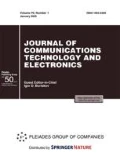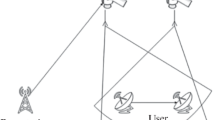Abstract
This paper evaluates inter-satellite communication for a low earth orbit CubeSat network. This paper consists of two parts: determination and estimation of quality of service (QoS) parameters and evaluation of the feasibility of a Massive Multiple Input Multiple Output (MIMO) system for inter-satellite links. CubeSats are low-cost and small satellites that were initially designed by students during the educational process but are now launched for conducting space research and for commercial use. Recently, some companies and research studies promoted CubeSats to build a wireless communication networks for different proposes, such as earth observation, weather forecasting, providing access to the internet, internet of things and machine to machine services. The main distinguishing features of a CubeSat network include low-cost and fast deployment with a consequent advantage: the possibility to build a large network (hundreds of spacecraft) with limited resources. However, due to the limited size and function of CubeSats, the feasibility of a CubeSat network with inter-satellite links is debatable. In this paper, we investigate the QoS parameters for an inter-satellite link and factors affecting it. The theoretical design with a constructive drawing of massive MIMO has been made. The possibility and time duration of inter-satellite communication has been calculated for three different cases using real data and including Massive MIMO. The simulation of orbit movements for groups of CubeSats has been made. The correlation between relative positions of satellites in orbits, parameters of communication channels and the QoS was determined. The feasibility of massive MIMO for CubeSat communications has been estimated. Based on simulation results, suggestions and possible technical and non-technical solutions were highlighted together with future studies and simulations.










Similar content being viewed by others
REFERENCES
A. Mehrparvar, D. Pignatelli, J. Carnahan, R. Munakat, W. Lan, A. Toorian, and S. Lee, “Cubesat design specification rev. 13,” in The CubeSat Program (Cal Poly San Luis Obispo, US, 2014).
“Characteristics, definitions and spectrum requirements of nanosatellites and picosatellites, as well as stems composed of such satellites,” Report ITU, ITU-R SA 2312-0 (2014).
Danil Bulanov, Yang Wang, and Qian-Bin Chen, “Feasibility of intersatellite communication for CubeSats,” DEStech Trans. on Comput. Sci. Eng. iceit (2017).
“Nanosatellite & Cubesat Database,” nanosats.eu. [Online]. Available: http://www.nanosats.eu/ [Accessed: Jan. 10, 2018].
“Planet–Company,” planet.com. [Online]. Available: https://www.planet.com/company/ [Accessed: Jun. 12, 2017].
“Startup planet labs controls the most private satellites-edgy labs,” edgylabs.com. [Online]. Available: https://edgylabs.com/2017/03/02/planet-labs-private-satellites/ [Accessed: Jun. 12, 2017].
D. G. Pantenkov and N. V. Gusakov, “Computer simulation of active phased array antenna,” Kosmich. Tekh. Tekhnol., No. 1, 34–39 (2013).
“CelesTrak: ”More frequently asked questions,” celestrak.com. [Online]. Available: http:// celestrak.com/columns/v04n05/ [Accessed: Jun. 12, 2017].
D. Vallado, P. Crawford, R. Hujsak, and T. S. Kelso, “Revisiting spacetrack report# 3,” in Proc. AIAA/AAS Astrodynamics Specialist Conf. and Exhibit, Guidance, Navigation, and Control and Co-Located Conf., Keystone, Colo, USA, Aug. 2006 (Am. Inst. Aeronautics and Astronautics, 2006), p. 6753.
Hoots, Felix R., Ronald L. Roehrich, and T. S. Kelso, “Spacetrack report No. 3,” in Project Spacetrack Reports, Office of Astrodynamics, Aerospace Defense Center, ADC/DO6 (Peterson AFB, CO 80914, 1980).
V. A. Chagina, D. A. Grishko, and V. I. Maiorova, “Satellite’s trajectory propagation at near circular orbits using TLE files in the simplified SGP model,” Sci. Education of Bauman MGTU, No. 1, 52–66 (2016). doi 10.7463/0116.0830533
E. Björnson, “Massive MIMO bringing the magic of asymptotic analysis to wireless networks,” in Int. Workshop on Computer-Aided Modeling Analysis and Design of Communication Links and Networks (CAMAD) Dec. 1, 2014.
Ta-Sung Lee, Massive MIMO and Its Applications in 5G Systems (Inst. Communications Engineering, National Chiao Tung Univ., 2016).
R. Heath, N. Gonzalez-Prelcic, S. Rangan, W. Roh, and A. Sayeed, “An overview of signal processing techniques for millimeter wave MIMO systems,” IEEE J. of Selected Topics in Signal Processing 10, 436-453 (2016). doi 10.1109/JSTSP.2016.2523924
G. Fokin, D. Volgushev, A. Kireev, D. Bulanov, and V. Lavrukhin, “Designing the MIMO SDR-based LPD transceiver for long-range robot control applications,” in Ultra Modern Telecommunications and Control Systems and Workshops (ICUMT), 2014 6th Int. Congress, 2014 (IEEE, 2014). doi 10. 1109/ICUMT.2014.7002144.
Assembly, ITU-R R12-CPM15.02-R-0001: “CPM Report on technical, operational and regulatory/procedural matters to be considered by the World Radiocommunication Conference”, Report (ITU, 862, 2015).
P. Muri and J. McNair, “A survey of communication sub-systems for intersatellite linked systems and CubeSat missions.” JCM 7, 290–308 (2012).
“Single CubeSat solar panels”, isispace.nl. [Online]. Available https://www.isispace.nl/product/isis-cubesat-solar-panels/ [Accessed: Jan. 10, 2018].
A. Akimov, V. Chazov, L. Kurakhtenkov and S. Smirnov. “Mobile satellite communication system Iridium: 18 years on service in space,” Zh. Tekh. i Sredstva Svyazi, No. 2, 56–61, (2016).
ACKNOWLEDGMENTS
This research was financially supported by the Chongqing University of Posts and Telecommunication Science Foundation (A2014-31 A2015-28), Chongqing Education Committee Fund (KJ1600417).
Author information
Authors and Affiliations
Corresponding author
Additional information
The article is published in the original.
Rights and permissions
About this article
Cite this article
Bulanov, D., Ocheretyanyy, K., Wang, Y. et al. Inter-Satellite Communication for LEO CubeSat Network: QoS Parameters and Feasibility of Massive MIMO. J. Commun. Technol. Electron. 63, 1174–1182 (2018). https://doi.org/10.1134/S1064226918100054
Received:
Published:
Issue Date:
DOI: https://doi.org/10.1134/S1064226918100054




